
2. To develop an understanding of the relationships between cell components and clinical features of disease
3. To explain the bacterial growth curve
4. To familiarize you with immune reactions induced by the bacterial cell
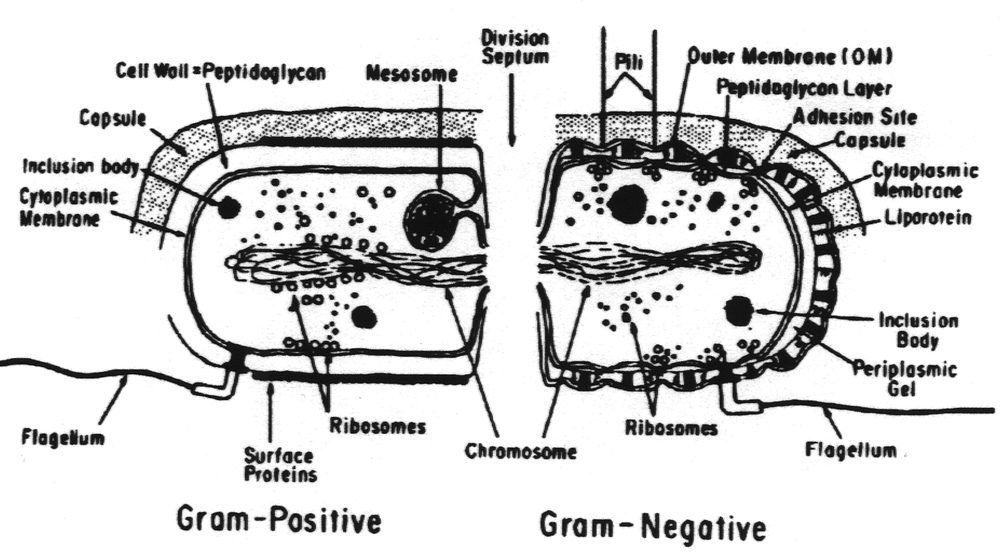
From Zinsser Microbiology, Joklik, et al., 19th ed., pp. 15, Figure 3-1. Reproduced with permission.
It is important to note the differences between the human (eukaryotic) cell and the bacterial (prokaryotic) cell because many of these differences account for disease pathogenesis and it has also been possible to exploit these differences in developing a chemotherapy regimen. In contrast to the human cell, the bacterial cell:
1. May have a capsule. Not all bacterial cells have a capsule but when it is present it is a major virulence factor. The capsule includes the K-antigen.
2. May have an outer membrane which is the outer surface of the cell or, in the case of encapsulated strains, lies just underneath the capsule. This has a trilaminar appearance. It contains lipopolysaccharides (LPS). These are known as endotoxins. They are also the somatic or O-antigen and are used in serological typing of species. These occur only in Gram-negative bacteria.
3. May have a periplasmic space which lies between the outer membrane and the plasma membrane. This is filled with the periplasmic gel which contains various enzymes. Again, this occurs only in the Gram-negative bacteria. 4. Has a rigid cell wall made of peptidoglycan (except for the mycoplasma). This cell wall is thick in Gram-positive bacteria and thin in Gram-negative bacteria. It is the thickness of the peptidoglycan that accounts for the ability/lack of ability to retain the crystal violet used in the Gram stain.
5. Has a cytoplasmic membrane lacking sterols (except for the mycoplasma). Up to 90% of the ribosomes are attached to this membrane. It also contains:
b. The membrane permeability (transport) systems.
c. Various polymer-synthesizing systems.
d. An ATPase.
7. May have a flagellum which arises from the plasma membrane and protrudes through the cell wall. This is the source of the H antigen which is used in serologic diagnosis. It is also the motility organ and possibly an organ for attachment to a human cell. It is considered a virulence factor.
8. Has hairlike microfibrils, termed fimbriae or pili, which originate in the plasma membrane and protrude through the cell wall. They are straighter, thinner and shorter than flagella. The pili contain chemical compounds called adhesins which allow the cell to bind to specific receptors on various human tissues. This binding gives rise to organ specificity of some bacterial strains. Fimbriae/pili are major virulence factors.
9. Has ribosomes attached to the plasma membrane and also free in the cytoplasm which have a mass of 70S (the human ribosome has a mass of 80S). The protein and RNA species in the bacterial ribosome differ from those in the human ribosome.
10. May have an endospore within the cytoplasm. This is a body that allows the organism to resist adverse conditions.
11. Has a nucleus lacking a nuclear membrane.
12. May have a circular plasmid. This is a small (relative to the chromosome) piece of DNA that often codes for virulence factors.
13. Has a haploid (single) chromosome.
There are many common themes in bacterial pathogenicity related to cell structure of the species. These are based on the presentation to the human body of the bacteria, its parts and its metabolites. When an organism, or more commonly a number of organisms of the same species, enters the human body and encounters no host defenses, it will exhibit a growth curve like the one depicted below for a closed system.
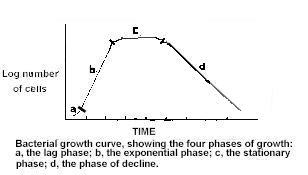
From Zinsser Microbiology, Joklik, et al., 20th ed., p. 63, Figure 5-10. Reproduced with permission.
In the lag phase there is an increase in cell size at a time when little or no cell division is occurring. During this phase, there is a marked increase in macromolecular components (many of which are toxic to the human cell), metabolic activity and susceptibility to physical and chemical agents. The lag phase is a period of adjustment necessary for the replenishment of the cell's pool of metabolites to a level commensurate with maximum cell synthesis.
In the exponential or logarithmic phase, the cells are in a state of balanced growth. During this state, the mass and the volume of the cell increase by the same factor in such a manner that the average composition of the cells and the relative concentrations of the metabolites remain constant. During this period of balanced growth, the rate of increase can be expressed by a natural exponential function.
The accumulation of waste products, exhaustion of nutrients, change in pH, induction of host immune mechanisms and other obscure factors exert a deleterious effect on the culture, resulting in a decreased growth rate. During the stationary phase, the viable cell count remains constant. The formation of new organisms equals the death of organisms in the system.
As the amount of the factors detrimental to the bacteria within the body increase, more bacteria are killed than are formed. During the phase of decline there is a negative exponential phase which results in a decrease in the numbers of bacteria within the system. During all phases of the bacterial growth cycle, the host is exposed to the components of the bacterial cell. This exposure results in the induction of pathology as well as of immune mechanisms. The outcome is either life or death of the human, depending on the relative rates of induction of these phenomena.
The chemical nature of the capsule is important in the functions the capsule plays in the infection process. The capsules of bacteria are chemically diverse but the majority of them are polysaccharide in nature. These polymers are composed of repeating oligosaccharide units of two to four monosaccharides. Some may contain acetic acid, pyruvic acid and/or the methyl esters of hexoses. At least two species of pathogenic bacteria produce protein capsules; Bacillus anthracis produces a capsule of pure D-glutamic acid and Yersinia pestis produces a capsule of mixed amino acids. Capsules may be weakly antigenic to strongly antigenic, depending on their chemical complexity. Capsules may be covalently linked to the underlying cell wall or just loosely bound to it. Not all bacteria form capsules but in those that do the capsule is the interface between the bacterial cell and the external environment. As such it may serve a diversity of functions in disease including:
2. Prevention of neutrophil killing of engulfed bacteria - lysosome contents do not have direct access to the interior of the bacterial cell and thus cannot kill the cell.
3. Prevention of complement-mediated bacterial cell lysis.
4. Prevention of polymorphonuclear leukocyte migration to the site of infection - Bacteroides fragilis produces a polysaccharide capsule high in succinic acid. Succinic acid is released from the capsule and paralyzes the pmn leukocyte.
5. Toxicity to the host cell - this takes many forms depending on the chemical nature of the capsule. One example is the capsule of B. fragilis which induces abscess formation.
6. Adhesion to the host cell.
7. Protection of anaerobes from oxygen toxicity.
8. Determination of colonial type - bacteria with capsules form smooth (S) colonies while those without capsules form rough (R) colonies. A given species may undergo a phenomenon called S-R variation whereby the cell loses the ability to form a capsule. Some capsules are very large and absorb water; bacteria with this type of capsule (e.g., Klebsiella pneumoniae) form mucoid (M) colonies.
9. Enhancement of the pathogenicity of other species in a mixed infection.
10. Receptors for bacteriophage.
11. Induction of antibody synthesis - this is the basis for:
b. Vaccine production. A polyvalent (23 serotypes) polysaccharide vaccine of Streptococcus pneumoniae capsule is available for high risk patients. There is also a polyvalent (4 serotypes) vaccine of Neisseria meningitidis capsule available. A monovalent vaccine made up of capsular material from Haemophilus influenzae is also available.
c. Quellung reaction
The capsule of bacteria may be penetrated by structures arising from the cell wall or plasma membrane such as cell wall specific polysaccharide, cell wall teichoic acid, plasma membrane lipoteichoic acid, flagella and pili.

From Zinsser Microbiology, Joklik et al, 19th Edition, pp 64, Figure 6-1. Reproduced with permission.
The glycan component is constituted of the two amino sugars, glucosamine and muramic acid. They occur as alternate ß-1, 4-linked N-acetyl-D-glucosamine and N-acetyl D-muramic acid residues. The glycan and peptide units are linked through the lactic acid carboxyl group of N-acetylmuramic acid to the amino terminus of a tetrapeptide. The glycotetrapeptides are cross-linked through the tetrapeptide units, forming a continuous 3-dimensional framework. While the tetrapeptide unit may vary with the species, the invariant feature of the tetrapeptide component is the presence of D-alanine, which is always the linkage unit between peptidoglycan chains.
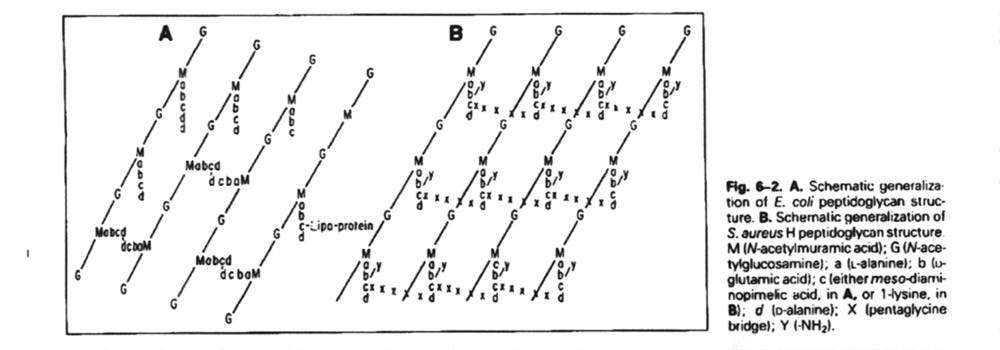
From Zinsser Microbiology, Joklik et al., 20th ed., p. 78, Figure 6-2. Reproduced with permission.
Thus, the cell wall can be several layers thick, each layer being a sheet of linked peptidoglycan units. The Gram-positive bacterial cell wall is distinguished by having multiple layers of peptidoglycan sheets and is thus up to ten times the thickness of a Gram-negative bacterial cell wall.
Attached to the rigid peptidoglycan framework of the cell wall are various polysaccharides which are covalently linked to the peptidoglycan. These fall into two groups:

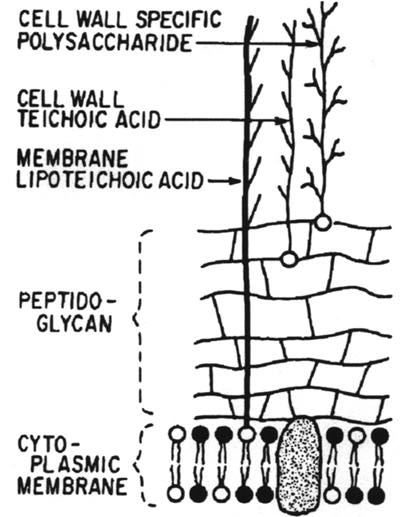
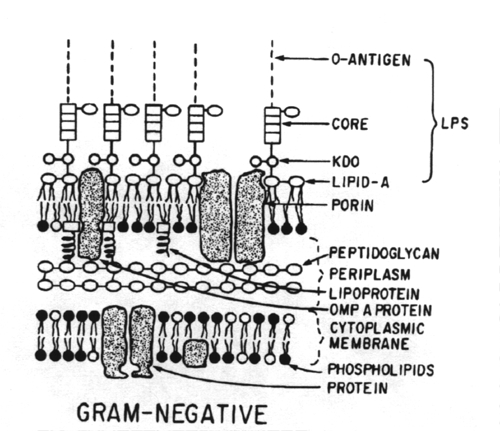
From Zinsser
Microbiology, Joklik et al., 20th ed., p. 81, Fig. 6-6. Reproduced
with permission.
Between the cytoplasmic membrane and the outer membrane is the periplasmic space containing a gel-like periplasm in which resides the cell wall peptidoglycan as well as various enzymes.
In addition
to phospholipids, the outer membrane contains unique Gram-negative lipopolysaccharides
(LPS) and various proteins (porons)
and lipoproteins. Each of these types of compounds is antigenic and is
used to speciate and subspeciate organisms serologically. Of these compounds
the LPS is the most important.

From Zinsser Microbiology , Joklik et al., 20th ed., p. 84, Fig. 6-11. Reproduced with permission.
LPS is an amphiphile composed of three regions: O-polysaccharide (the O- or somatic-antigen), the core polysaccharide and lipid A. Lipid A is anchored in the outer membrane. LPS is also known as endotoxin.
The peptidoglycan of the Gram-negative cell is chemically similar to but not identical with the peptidoglycan of the Gram-positive cell. The major difference between the two cell types is in the thickness of the peptidoglycan rather than the chemical makeup.
When the bacterial cell wall is placed in the environment of the human body as part of a viable microorganism, there is a diversity of functions/effects that can be noted. Some of these are specific for Gram-negative organisms (due to the relative complexity of their cell walls) and some are general. The functions/effects of the cell wall include:
2. Enhancement of the immune response to various cell metabolites by muramyldipeptide (N-acetylmuramyl-L-alanyl-D-isoglutamine), i.e., it is an adjuvant
3. Induction of fever by muramyldipeptide (i.e., its a pyrogen)
4. Induction of sleep by muramyldipeptide (i.e., its a somnogen)
5. Competition of muramyldipeptide with serotonin (5-hydroxytryptamine) for receptors on macrophages. Serotonin, when bound to the macrophage, enhances the chemotactic response of the macrophage. Thus, muramyldipeptide blocks this response in the inflammatory reaction.
6. Induction of inflammatory arthritic joint disease by peptidoglycan-linked polysaccharides (e.g., the polysaccharide of group A streptococci linked to peptidoglycan)
7. Induction of granulomatous liver disease by peptidoglycan-linked polysaccharides
8. Stimulation of hemopoietic stem cells by peptidoglycan-linked polysaccharides
9. Induction of chronic inflammatory bowel disease (i.e. Crohn's disease) by peptidoglycan-linked polysaccharides, especially those of Mycobacterium paratuberculosis.
10. Induction of the immune response by the teichoic acids of Gram-positive bacteria. This response is used in the serological identification of Gram-positive bacteria.
11. Induction of the immune response by the O-polysaccharide (somatic antigen) portion of the lipopolysaccharide of the outer membrane of Gram-negative bacteria. This response is used in the serological identification of the Gram-negative bacteria.
12. Endotoxin (LPS) induction of:
B. Shwartzman reaction - hemorrhagic necrosis at the site of infection following exposure of another part of the body to a relatively small amount of Lipid A. This is due to the clearing of fibrin polymers at the inflammation site.
C. Disseminated intravascular coagulation - this can lead to lethal shock. For this reason, it is especially important in patients (e.g., with carcinoma) who suffer chronic disseminated intravascular coagulation (defined as a 10-20% decrease in circulating platelets and clotting factors).
D. Macrophage production of tumor necrosis factor which results in various effects including:
(2) Adherence of polymorphonuclear leukocytes to the vascular endothelium, causing them to degranulate and form reactive oxygen intermediates such as superoxide anion and hydrogen peroxide. This promotes tissue necrosis and circulatory collapse.
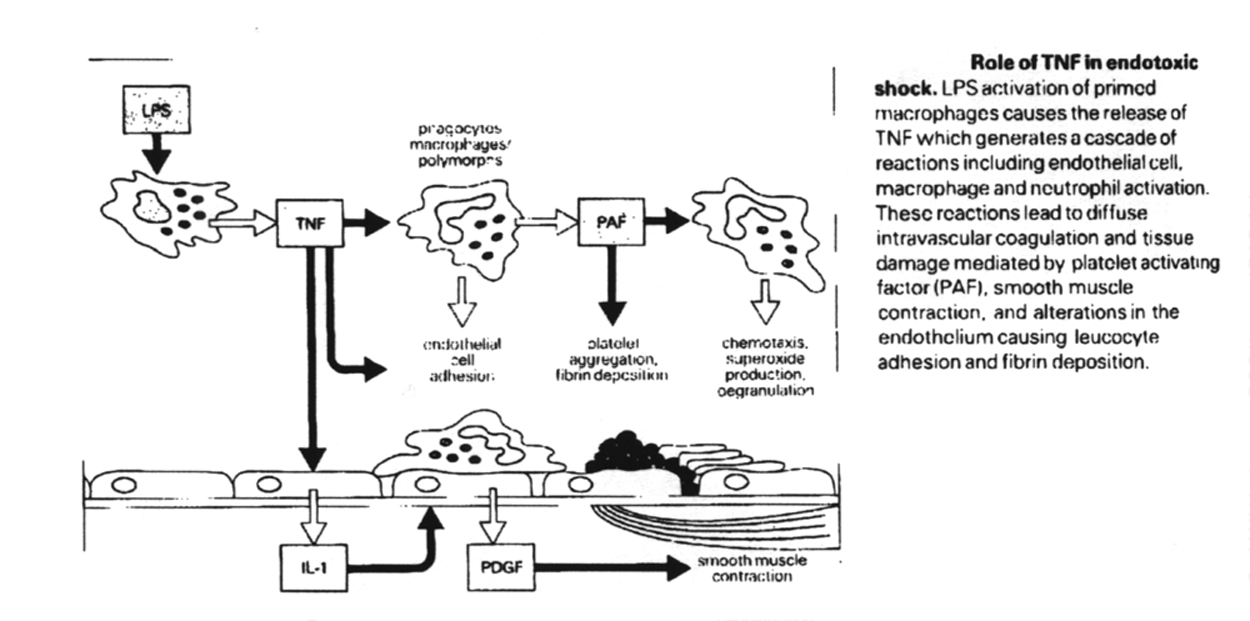


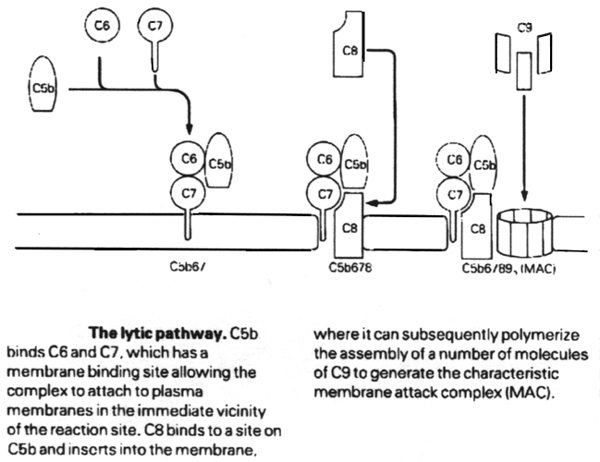
F. Stimulation of bone marrow cell proliferation.
G. Nonspecific enhancement of immune responses (i.e., action as adjuvants).
H. Enhancement of radiation resistance
I. Clotting of horseshoe crab amebocyte lysates (Limulus lysate reaction).
J. Engender hypersensitivity reactions
13. Functioning of the outer membrane of the Gram-negative cell wall as:
B. A molecular sieve for small water-soluble molecules.
C. An absorption site for bacteriophage
D. An absorption site for cellular conjugation
E. A reservoir for proteases, other enzymes and toxins

2. Type I and type II pili promote adhesion to human cells with these results:
b. Binding of bacterial cells to epithelial adhesion receptors which results in interactions which may kill the human cell. For example, Neisseria gonorrhoeae is avirulent if it lacks pili.
2. All bacteria are classified as Gram-positive (retain the gram stain) or Gram-negative (do not retain the gram stain).
3. Structural features of bacteria that are not seen in the human cell, or differ from those in the human cell, include a capsule, an outer membrane, a periplasmic space, a rigid cell wall, a cytoplasmic membrane lacking sterols , the mesosome, flagellum, fibrae (pili), 70S ribosomes, endospore, lack of a nuclear membrane, plasmids and a haploid chromosome.
4. The major antigens of the bacterial cell are the capsule (K-antigen), the lipopolysaccharide (O-antigen) and the flagellum (H-antigen).
5. The growth cycle of a culture of bacteria is divided into four phases: lag phase, exponential phase, stationary phase, decline phase.
6. The capsule of bacteria is most commonly polysaccharide in nature but proteinaceous in at least two species, Bacillus anthracis and Yersinea pestis.
7. The capsule is a major virulence factor that allows bacteria to evade phagocytosis, avoid the killing effects of lysosomal enzymes, avoid complement-mediated cell lysis, paralyze leukocytes, induce pathology in the host tissue, adhere to the host cell, protect anaerobic cells from oxygen toxicity, produce a unique colony type, enhance its pathogenicity, adsorb bacteriophage and induce antibody synthesis.
8. Bacteria with capsules from smooth (S) colones; those without a capsule from rough (R) colonies; those with hydrophilic capsules from mucoid (M) colonies.
9. Serologically, the capsule is important in diagnosis, vaccine production and as the basis for the Quellung reaction.
10. The cell wall of bacteria is made up sheets of cross-linked repeating units of peptidoglycan. In Gram-positive cells this is relatively thick as compared to Gram-negative cells.
11. Linked to the cell wall of bacteria are teichoic acids, cell wall specific polysaccharides and, in some cases, proteins of special significance.
12. Gram-negative bacterial cells contain lipopolysaccharide (LPS) in their outer membrane. This is the source of the O-antigen and endotoxin. 13. The functions/effects of the cell wall include maintenance of the morphology or the bacterial cell, action as an adjuvant, induction of fever, induction of sleep, competition with serotonin for receptors on macrophages, induction of inflammation, induction of liver granuloma, stimulation of hemopoietic stem cells, induction of bowel inflammation, induction of antibody synthesis.
14. Endotoxin induces fever, hemorrhagic necrosis (Shwartzman reaction), disseminated intravascular coagulation, production of tumor necrosis factor, activation of the alternate complement pathway, stimulation of bone marrow cell proliferation, enhancement of the immune and the Limulus lysate reaction.
15. The lipoteichoic acid of Gram-positive bacteria acts similar to the endotoxin of Gram-negative bacteria.
16. Pili contain adhesins which allow the bacterial cell to bind to human cells.
17. Flagella are organs of locomotion that are used in serotyping strains of bacteria.
![]()
Previous
Lecture
Top
of lecture
Home
Next
Lecture
![]()